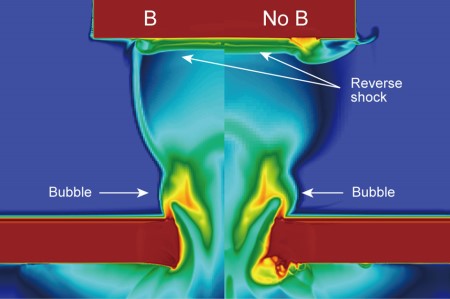Accretion processes are among the most important phenomena in high-energy astrophysics as they are widely believed to provide the power supply in several astrophysical objects (from stellar objects to massive black holes), and are the main source of radiation in a large number of interactive binary systems. The release of gravitational energy in the form of radiation energy is a complex physical process but fundamental in interpreting astronomical observations.
Among the numerous accretion systems, from young stellar objects to active galactic nuclei, the research group from Ecole Polytechnique of Paris is particularly interested in those where an accretion column is believed to be formed (polars). They are close binary systems containing a white dwarf (WD) that accretes matter from a late type Roche-lobe filling secondary star. In these systems, the magnetic field is strong enough to prevent the formation of an accretion disk, so matter piles up to the compact object’s magnetic poles, leading to the formation of an accretion column. These objects are potential embryos of thermonuclear supernovae, standard candles that allow us to measure the distance of distant galaxies, and their cosmological repercussions. Therefore, in studying polars the researchers can provide some answers to the cosmological challenges. The impact of the supersonic free-fall accreting matter on the WD photosphere leads to the formation of a radiative reverse shock and gives rise to strong emission from soft to hard x-rays. Astronomical observations showed unexplained luminosity oscillations, which could be related, for example, to unstable thermal oscillations of the shock front or magnetohydrodynamics (MHD) instabilities in the accretion column. As the reverse shock position in these systems is too close to the WD photosphere (~ 100-1000 km), the accretion region is unresolved by direct observations and structural parameters such as the shock height, temperature cannot be defined. The structure of this high-energy environment depends as well on multi-scale physics introducing issues for theoretical and numerical modeling. The members from research group have developed a new experimental platform that couples a strong external magnetic field (up to 15 T) with high-power lasers (∼kJ), enabling to collimate the flow without using a tube and to study the magnetized reverse-shock dynamics related to accretion processes with a particular emphasis on POLAR. Related results are published in High Power Laser Science and Engineering, Vol. 6, Issue 3, 2018 (B. Albertazzi, et al., Experimental platform for the investigation of magnetized-reverse-shock dynamics in the context of POLAR).
“The only way to study these systems in detail is to reproduce a scaled astrophysical experiment” said Dr. Bruno Albertazzi. Preliminary results show that an instability seems to develop in the accretion column and the structure of the magnetized reverse shock seems complex but needs to be confirmed in future work.

2D MHD radiative Flash simulation performed 75 ns after the beginning of the interaction.


